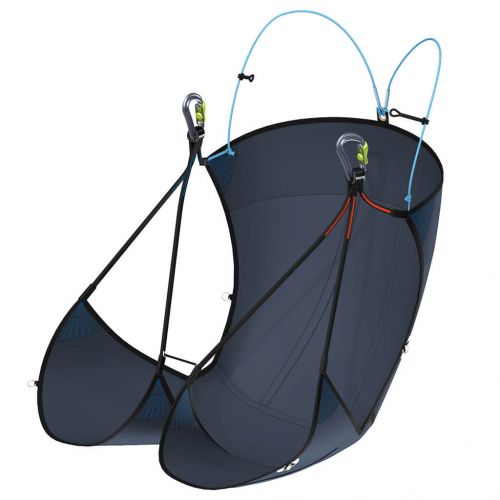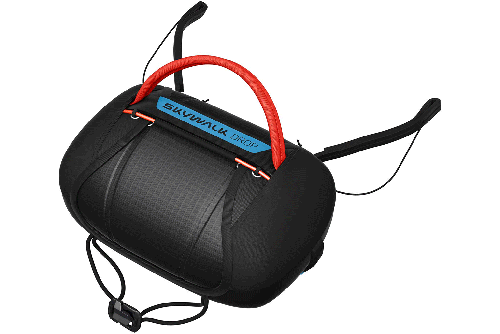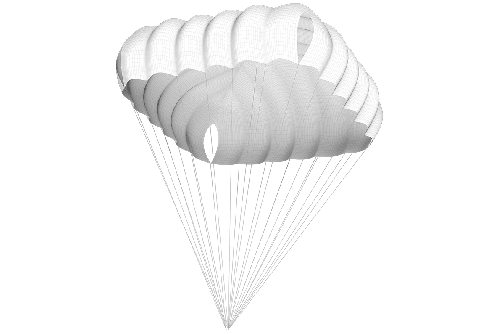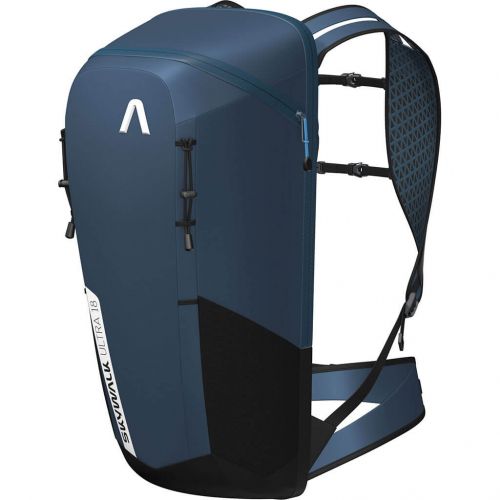What’s your pace?
With its ultra-small packing size and minimal weight (from 1.05 kg), the PACE single skin is the lightest paraglider with LTF/EN B certification. In collaboration with Jean-Baptiste Chandelier, we have developed a glider that sets new standards. Especially for trail runners, climbers and ambitious alpinists, the PACE offers the perfect descent aid after challenging tours. The areas of use are almost limitless, as the PACE hardly weighs anything.
Together with our ultra-light products – the SLEEVE harness and the ULTRA backpack, the TAPA X-ALPS rescue and the DROP front container – the result is a safety package that is perfectly matched to each other. The complete package weighs just over 2 kilograms!
HOW DOES THE PACE FLY?
The PACE launches almost by itself. You don’t even have to take the risers in your hands. Just a slight impulse via the harness is enough and the canopy is immediately above the pilot. The ultralight wing rises very quickly, but stops on its own and does not overshoot. With only a few steps you are already in the air. Therefore, the PACE is perfect for launching on the smallest take-off sites as well as in very difficult terrain.
In the air, the PACE reacts directly to control impulses, flies very intuitively and with playful ease. The control pressure is very low. In turbulence, the design of the PACE offers extremely high resistance to collapses and exceptional inherent stability. The PACE stabilises itself and aligns itself again above the pilot when needed. As a result, there is hardly any pendulum movement during the exit of a spiral dive.
It is important while landing with a single skin to fly as fast as possible on final approach in order to create a pleasant flare effect. Applying the brakes too early can completely destroy the lift. The PACE has been equipped with the NUDGE system. This generates an extra lift on landing by additionally applying the C-risers from a certain brake application.
The PACE can be upgraded with a trimmer system. This does not only increase the trimming speed, but also improves the flare characteristics. Please note that the EN/LTF type approval expires if the trimmer system is fitted and used.
For more details on flight behaviour and handling, check out our PACE tutorial.
 SELF INFLATING LEADING EDGE
SELF INFLATING LEADING EDGE
The closed leading edge reduces weight, ensures consistently good takeoff behavior and increases speed in a single skin design.
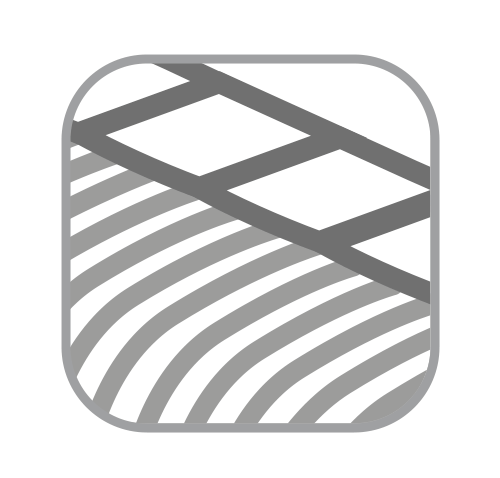 MONO PANEL
MONO PANEL
A summary of the cells in the rear section of the wing enables an extremely low weight, reduces the number of profile ribs and simplifies the pre-flight preparations.
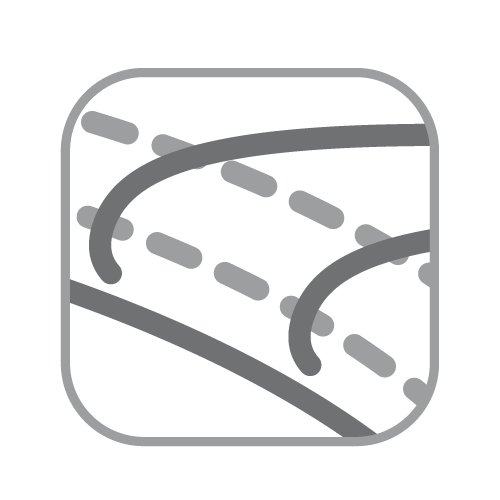 3D-SHAPING
3D-SHAPING
A precise calculation of the leading edge geometry and the installation of an additional strip of fabric reduce wrinkling in this sensitive part of the glider. Advantages: exact wing shape, more performance.
 RIGID FOIL
RIGID FOIL
Nylon wires & nitinol keep the leading edge and the profile in shape and ensure a better form stability. Advantages: better take-off behaviour and more performance.
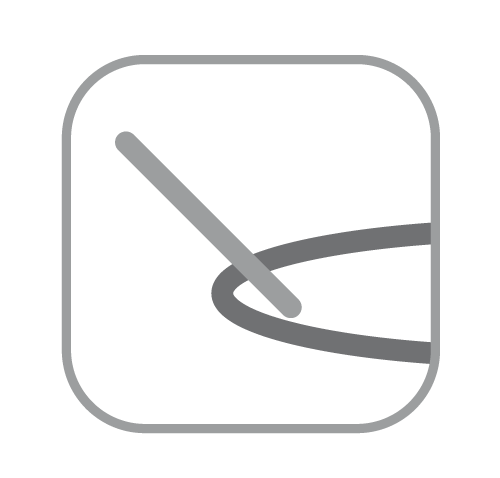 LOOPS & HOOKS
LOOPS & HOOKS
Two sewn-in loops on the upper surface in the leading edge area enable to attach hook pins to lay out the canopy in challenging alpine terrain.
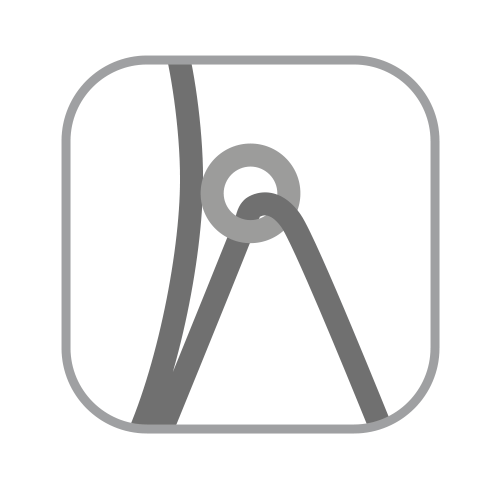 NUDGE SYSTEM
NUDGE SYSTEM
Generates additional lift during landing and improves flare characteristics.
 SMART LINK SYSTEM
SMART LINK SYSTEM
Color coded seams on the risers to ensure that the risers are connected correctly and without being twisted.
red = left, blue = right
Technical data
| Size | 70+ | 85+ | 95+ |
|---|---|---|---|
| Cell number | 41 | 41 | 41 |
| Area flat [m²] | 16 |
18 | 20 |
| Area projected [m²] | 13,63 | 15,34 |
17,04 |
| Wingspan flat [m] | 8,39 | 8,9 |
9,38 |
| Wingspan projected [m] | 6,72 | 7,13 | 7,51 |
| Aspect ratio flat | 4,4 |
4,4 |
4,4 |
| Aspect ratio projected | 3,31 | 3,31 |
3,31 |
| min. profile depth [cm] | 78 | 83 |
87 |
| max. profile depth [cm] | 229 | 243 | 256 |
| Weight [kg] |
1,05 | 1,15 | 1,24 |
| Take-off weight from - to [kg] |
50 - 90 | 65 - 100 | 70 - 110 |
| Homologation |
LTF/EN B | LTF/EN B | LTF/EN B |
Materials
| Upper sail | Porcher Skytex 27 double coated, Dominico 10D |
|---|---|
| Ribs | Porcher Skytex 27g hard, Skytex 32g hard |
| Main lines | Liros PPSLS 180/125; Edelrid 8001U - 70 |
| Middle lines | Edelrid 8001U - 130/90/70/50 |
| Top lines | Liros DC 35 |
| Brake lines | Liros DFLP 200/32, PPSL 125, DC 35; Edelrid 8001U - 90/50 |
| Risers | 4mm Amare |
- 1x Inner bag
- 1x Compression strap
- 1x Riser bag
- 1x Deflation bag
- 1x Pair Hook Pins
- 1x BASIC Guide
- 1x Bandana
- 1x Sticker set
- 1x Self-adhesive repair patch
What size should I choose for this glider?
In comparison to a conventional paraglider, a single skin wing is more sensitive to wing loading and will fly slower with slightly less wing loading; faster and more dynamically with slightly higher wing loading. The graphic helps you to choose the right size.

How do I calculate my take-off weight?
Takeoff weight is calculated by adding the weight of the pilot including clothes to the weight of the equipment. The equipment consists of the harness, the reserve chute, the paraglider itself, and any flight instruments and other baggage you may carry (e.g. rucksack, etc.).
What are "Loops & Hooks" and how do I use them?
In difficult terrain, you can attach ribbons to the loops, which are then weighted with an object (stone, branch, etc.). This keeps the leading edge open prevents the wing from sliding away in steep terrain.
Light-cloths are thinner than conventional glider-cloths and therefore less resistant against mechanical strain. That means you need to pay more attention on small rocks and bushes. Please avoid any unnecessary contact to the ground. With this strict observance you will have the same durability as with a conventional glider-cloth.
Does the PACE has an acceleration system?
No, the PACE does not have an accelerator but can be equipped with the optionally available trimmer system. This increases the trim speed and enhances the flare behavior.
You can find the How-To video for the trimmer system at the following YouTube link: https://youtu.be/KArOBYhxr6s
Caution: When using the trimmer system, the certification according to LTF/EN is no longer valid!
What are the glide ratio (L/D), trim and maximum speeds?
We know that these data are interesting for you as a pilot, but for us to publish them would be a bad idea for the following reasons:
- Performance data are highly dependent on the drag of the pilot and are thefore related to sitting position and harness. The difference between aerodynamically favorable and unfavorable harnesses and sitting positions can be as much as a whole L/D number.
- Performance increases with the size of the glider. A large glider will always outperform the same glider in a smaller size. So a question about the performance of a glider is always also a question about the size.
- There is no normed method of testing the performance of paragliders. For example, speed varies with altitude and the associated different air pressure, but also with the total weight of the system. That means that there simply isn’t THE speed or THE L/D that would allow a serious comparison with another glider. Performance data are dependent on the harness, the size of the glider, on the air mass and the total weight.
Is it OK for me to shorten the brake lines on my skywalk paraglider?
Changing the length of the brake lines can have a negative effect on the flying characteristics and extreme flight behavior. The paraglider needs a little more lead when flying on speed bar, otherwise the glider could be braked unintentionally, leading to a loss of performance. When performing extreme flying maneuvers, shortening the brake lines too much can cause complications during recovery from collapses, parachutal stall, etc.
Am I allowed to make modifications to my skywalk paraglider?
No, because the glider is certified the way it is delivered to you. Even the brake line length is part of the trim and must not be changed.
Do the nylon wires in the glider need any special attention or packing method?
Our nylon wires are flexible and kink resistant, so they won’t break under normal circumstances. But due to the packing volume it is a good idea to lay the Rigid Foils in the leading on top of each other on both sides.
Is the PACE suitable for winch towing?
Yes, the PACE is well suited for winch towing. When launching on a winch, always fly with a lot of feeling and don’t brake too much as your glider will already have an increased angle of attack. We recommend the use of a towing adapter. Make sure that you only use certified winches and that you climb from the ground at a flat angle.

